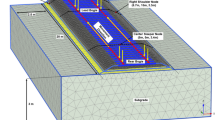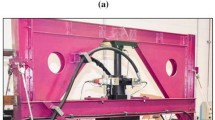Abstract
The railway embankments are always subjected to cyclic loads which lead to track deterioration. The rehabilitation and maintenance of the tracks require the materials to be economical and readily available on or near the site. The use of polymer materials such as geogrids is widely accepted in highway designs and is increasingly becoming common in railways. The current study focuses on improving the substructure by considering the role stiffness play in making the embankment fit for high-speed trains up to a speed of 300 kmph using European guidelines as a reference. A plate load test (DIN 18134) for railway embankments is used to conduct experiments by placing geogrids at the ballast and subgrade interfaces, where the modulus of the embankment is evaluated. The results confirm the improved behavior of the embankment with over 15% enhancement in stiffness of the embankment and provide simplistic method to design and even rehabilitate the embankment based on modulus values.









Similar content being viewed by others
Data Availability
All data generated or analyzed during this study are included in this published article.
References
Fei J, Jie Y, Hong C, Yang C (2020) Comparative analysis of design parameters for high-speed railway earthworks in different countries and a unified definition of embankment substructure. Baltic J Road Bridge Eng. https://doi.org/10.7250/bjrbe.2020-15.476
Shukla SK (2012) Chapter 1: Fundamentals of geosynthetics. In: Shukla SK (ed) Handbook of geosynthetic engineering, 2nd edn. ICE Publishing, London, pp 1–44
Shukla SK, Yin JH (2006) Fundamentals of geosynthetic engineering. Taylor and Francis Group, London
AG DN (2014) RIL 836 Erdbauwerke und geotechnischeBauwerkeplanen, bauen und instandhalten [Earthworks and geotechnical structures design, construction and maintainance]. DB Netze AG, Frankfurt am Main, p. 530 [in German]
Alamaa A (2016) High-speed railway embankments: a comparison of different regulations. Master’s thesis, KTH Royal Institute of Technology, Stockholm, Sweden
Code UIC (2008) 719R Earthworks and track bed for railway lines. Union Internationale des Chemins de Fer, Paris, p 117
Jain VK, Keshav K (1999) Stress distribution in railway formation—a simulated study. Pre-failure deformation characteristics of geomaterials. A.A. Balkema, pp 653–658
Raymond GP (1999) Railway rehabilitation geotextiles. Geotext Geomembr 17(4):213–230. https://doi.org/10.1016/S0266-1144(99)00002-3
Raymond GP (2002) Reinforced ballast behavior subjected to repeated load. Geotext Geomembr 20(1):39–61. https://doi.org/10.1016/S0266-1144(01)00024-3
Shin EC, Kim DH, Das BM (2002) Geogrid-reinforced railroad bed settlement due to cyclic load. Geotech Geol Eng 20(3):261–271. https://doi.org/10.1023/A:1016040414725
Indraratna B, Khabbaz H, Salim W, Christie D (2006) Geotechnical properties of ballast and the role of geosynthetics in rail track stabilization. Proc Inst Civ Eng Ground Improv 10(3):91–101
Indraratna B, Nimbalkar S, Christie D, Rujikiatkamjorn C, Vinod J (2010) Field assessment of the performance of a ballasted rail track with and without geosynthetics. J Geotech Geoenviron Eng 136(7):907–917. https://doi.org/10.1061/(ASCE)GT.1943-5606.0000312
Indraratna B, Nimbalkar S, Neville T (2014) Performance assessment of reinforced ballasted rail track. Proc Inst Civ Eng Ground Improv 167(1):24–34
Palmeira EM, Góngora IA (2016) Assessing the influence of some soil–reinforcement interaction parameters on the performance of a low fill on compressible subgrade. Part I: fill performance and relevance of interaction parameters. Int J Geosyn Ground Eng 2(1):1. https://doi.org/10.1007/s40891-015-0041-3
Ngo NT, Indraratna B (2016) Improved performance of rail track substructure using synthetic inclusions: experimental and numerical investigations. Int J Geosyn Ground Eng 2(3):1–16. https://doi.org/10.1007/s40891-016-0065-3
Biswas A, Ansari MA, Dash SK, Krishna AM (2015) Behavior of geogrid reinforced foundation systems supported on clay subgrades of different strengths. Int J Geosyn Ground Eng 1(3):1–10. https://doi.org/10.1007/s40891-015-0023-5
Emersleben A, Meyer N (2008) The use of geocells in road constructions over soft soil: vertical stress and falling weight deflectometer measurements. In: Proceedings of 4th European Geosynthetics Conference, Edinburgh
Minažek K, Mulabdić M (2014) Determination of reinforced soil stiffness by static plate load test. In: 10th International Conference on Geosynthetics (10 ICG). DGGT, IGS, Berlin
Nie RS, Leng WM, Yang Q, Chen YF, Xu F (2018) Comparison and evaluation of railway subgrade quality detection methods. Proc Inst Mech Eng, Part F J Rail Rapid Transit 232(2):356–368. https://doi.org/10.1177/0954409716671551
Tompai Z (2008) Conversion between static and dynamic load bearing capacity moduli and introduction of dynamic target values. Periodica Polytech Civ Eng 52(2):97–102. https://doi.org/10.3311/pp.ci.2008-2.06
Correia AG, Martins J, Caldeira L, Das Neves EM, Delgado J (2009) Comparison of in situ performance-based tests methods to evaluate moduli of railway embankments. In: Bearing Capacity of Roads, Railways and Airfields, 8th International Conference (BCR2A’09) University of Illinois, Urbana-Champaign, Illinois, USA, June 29–July 2, pp 1331–1340
Kim D, Park S (2011) Relationship between the subgrade reaction modulus and the strain modulus obtained using a plate loading test. In: Proceedings of the 9th World Congress on Railway Research, Lille, France, May
Hegde A, Sitharam TG (2016) Behaviour of geocell reinforced soft clay bed subjected to incremental cyclic loading. Geomech Eng 10(4):405–422. https://doi.org/10.12989/gae.2016.10.4.405
Sun X, Zhao MJ, Wang K (2016) Laboratory test method for second deformation modulus Ev2. Electr J Geotech Eng 21:6771–6780
White DJ, Vennapusa PK (2017) In situ resilient modulus for geogrid-stabilized aggregate layer: a case study using automated plate load testing. Transp Geotech 11:120–132. https://doi.org/10.1016/j.trgeo.2017.06.001
Rajagopal K, Krishnaswamy NR, Latha GM (1999) Behaviour of sand confined with single and multiple geocells. Geotext Geomembr 17(3):171–184. https://doi.org/10.1016/S0266-1144(98)00034-X
Innotrack (2006) Integrated Project No. TIP5-CT-2006-031415: D2.2.6. GL, Guideline for subgrade reinforcement with geosynthetics
Lehmann S, Leppla S, Norkus A (2020) Experimental study of the modulus of deformation determined by static and dynamic plate load tests. Baltic J Road Bridge Eng. https://doi.org/10.7250/bjrbe.2020-15.497
DIN 18134:2001–09 (2001) Determining the deformation and strength characteristics of soil by plate loading test. Deutsche Institutfür Normung
Shukla SK (2022) Seven research mantras: a short guide for researchers. Int J Geosyn Ground Eng 8(6):751–754. https://doi.org/10.1007/s40891-022-00419-6
GE-14-RDSO (2007) Guidelines for blanket layer provision on track formation. Design and Standard Organisation (RDSO), Ministry of Railways, India
Bhardwaj A, Mittal S (2020) Performance behavior of geogrids at interface of ballast and granular soil. Indian Geotech J. https://doi.org/10.1007/s40098-020-00424-4
Prasad BD, Hariprasad C, Umashankar B (2016) Load-settlement response of square footing on geogrid reinforced layered granular beds. Int J Geosyn Ground Eng 2(4):1–10. https://doi.org/10.1007/s40891-016-0070-6
Acknowledgements
This study was conducted under grant MHR-002, received from the Government of India, Ministry of Human Resource and Development (MHRD).
Author information
Authors and Affiliations
Contributions
All authors contributed to the study’s conception and design. Material preparation, data collection, and analysis were performed by AB. The first draft of the manuscript was written by AB and all the work was performed under the supervision and guidance of SM. All authors commented on previous versions of the manuscript. All authors read and approved the final manuscript.
Corresponding author
Ethics declarations
Conflict of Interest
There is no potential conflict of interest for the undertaken study.
Additional information
Publisher's Note
Springer Nature remains neutral with regard to jurisdictional claims in published maps and institutional affiliations.
Rights and permissions
Springer Nature or its licensor (e.g. a society or other partner) holds exclusive rights to this article under a publishing agreement with the author(s) or other rightsholder(s); author self-archiving of the accepted manuscript version of this article is solely governed by the terms of such publishing agreement and applicable law.
About this article
Cite this article
Bhardwaj, A., Mittal, S. Enhancing Stiffness Behavior of Railway Embankment for High-Speed Tracks with Geogrids. Int. J. of Geosynth. and Ground Eng. 9, 64 (2023). https://doi.org/10.1007/s40891-023-00484-5
Received:
Accepted:
Published:
DOI: https://doi.org/10.1007/s40891-023-00484-5




